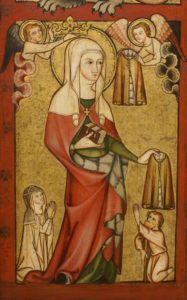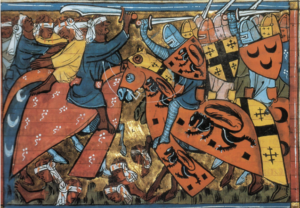[Missed part 1? Find it here.]
 The fifteenth-century hagiography of Elisabeth Achler, a Franciscan tertiary from Reute, ascribes to her the standard catalogue of proper saintly elements. She could almost be the exemplar of a late medieval holy woman. But her hagiographer, Augustinian prior Konrad Kügelin, does not stop with standard recitations of virtues and somatic spirituality. In almost every category, Achler is said to exceed even the most frenetic reports of her role models’ own deeds.
The fifteenth-century hagiography of Elisabeth Achler, a Franciscan tertiary from Reute, ascribes to her the standard catalogue of proper saintly elements. She could almost be the exemplar of a late medieval holy woman. But her hagiographer, Augustinian prior Konrad Kügelin, does not stop with standard recitations of virtues and somatic spirituality. In almost every category, Achler is said to exceed even the most frenetic reports of her role models’ own deeds.
But at the same time, there is a much more prosaic story that underlies the high-flying discourse of sainthood. Werner Williams-Krapp’s argument that Kügelin worked hard in the vita to make Achler seem more exciting is undeniably correct. One of her “miracles” involves administering aid to a beggar who came to the cloister door one night. Kügelin remarks that, in his understanding, the poor wanderer was none other than Christ himself.[i] To a skeptical reader, the miracle exists only in his mind. But to the Augustinian, that mode of interpretation was not even remotely under consideration. Not only is the mysterious visitor anecdote not the only example of miracle-by-explanation, but the vita is stocked with events whose “miraculous” interpretation seems less of an explaining and more of an explaining-away.
When the devil beats up Achler, for example, he takes her into her room and locks the door first—from the inside. He does such a good job of it that Kügelin has to break the door down in order to get to Achler, mysteriously now on her own with only the wounds to show for the encounter. And at one point during her twelve-year period of fasting, her fellow sisters noticed bread and meat and other food going missing from the kitchen.[ii] They found it under Achler’s bed! Kügelin explains that the devil had taken the form of his saint to fool others and cause hardship for her. But the devil is not finished. First of all, this happened again.[iii] But this time there was more. A woman who did not eat would not have bowel movements, of course. And her sisters found feces hidden in Achler’s room! Once again they accused her of eating in secret, and once again this caused her great pain and hardship. Of course, Kügelin insists, the devil had put it there for that very reason. And when this problem was taken care of, her sisters found more excrement in the garden outside Achler’s window. You guessed it–the devil had thrown it there.
Since the explosion of interest in medieval hagiography, especial of women, scholars have dealt with the extranormal elements by agreeing to read the text as people read it at the time of its composition. But there are some cases when discourse so clearly breaks down that a more prosaic approach is compelling. In Kügelin’s literary desire to align Achler with the elements of sanctity, we see instead her desire, and even desperation, to conform to the standards. More to the point, we see her fail—and still maintain the facade, despite being confronted with the knowledge that she was not, by the standards of the ideal of holiness, in fact holy. Sanctity as an ideal and as a practice is stretched molecularly thin.
But as Siegfried Ringler points out, Achler is the one High German religious woman of the late Middle Ages who produced an enduring cult.[iv] An early sixteenth-century vita of an observant prioress memorializes her as a teacher of virtue; Baroque-era poetry hails her as a saint.[v] She was even officially beatified by the Church in the eighteenth century. Her to-us obvious “faking it” was successfully obscured at the time. This is particularly noteworthy because her life was the age that jump-started clerical condemnation of women’s ecstatic and public religious activity.[vi] And when the standards of late medieval piety that Achler ruined her adulthood to meet dissolved into suspicion and frequent condemnation over the course of the century, her cult rewrote her into their exemplar of virtuous devotion and instruction.[vii]
In the case of Elisabeth Achler and her hagiographer, therefore, the ideal of sainthood was pulled and pulled—and instead of snapping, it sprang back like a rubber band. For a fifteenth century infamous for its suspicion and suppression of ecstatic women’s spirituality, Achler is both a reason for it and an escape artist from it. The lives and texts of religious women at the end of the Middle Ages are often considered stereotypical, monotonous, and (to us) unrealistic.[viii] The interaction of hagiography, the ideal of sainthood, and the challenges of those two applied to the real life of a real woman that we see with Elisabeth Achler shows that those things are probably all true—but that is not the end of investigation, it’s a new beginning.
Cait Stevenson, PhD Candidate
University of Notre Dame
~~
[i]Leben12.
[ii]Leben6.
[iii]Leben12.
[iv]Ringler, 429.
[v]Juliana Ernestin, Chronik des Bickenklosters zu Villingen, 1238 bis 1614, ed. Karl Jordan Glatz (Tübingen: Litterarisches Verein in Stuttgart, 1881); on the seventeenth-century poetry, see Bihlmeyer 94.
[vi]See, for example, Dyan Elliott, Proving Woman: Female Spirituality and Inquisitional Culture in the Later Middle Ages (Princeton: Princeton University Press, 2004); Ulla Williams and Williams-Krapp, “Eine Warnung an alle, dy sych etwaz dyncken: Der >Sendbrief von Betrug teuflischen Erscheinungen< (mit einer Edition),” in Forschungen zur deutschen Literatur der spaten Mittelalters: Festschrift für Johannes Janota, ed. Horst Brunner and Williams-Krapp (Tübingen: De Gruyter, 2003).
[vii]See n. 13 above.
[viii]See, for example, Anneke B. Mulder-Bakker, “Holy Women in the German Territories,” in Medieval Holy Women in the Christian Tradition, 1000-1500, ed. Alastair Minnis and Rosalynn Voaden ( ), 325, who encapsulates Achler’s life as: “She followed the Third Rule of St. Francis, cared for the poor, and made a living by weaving. Elizabeth was deeply touched by God’s grace and received the stigmata.”


